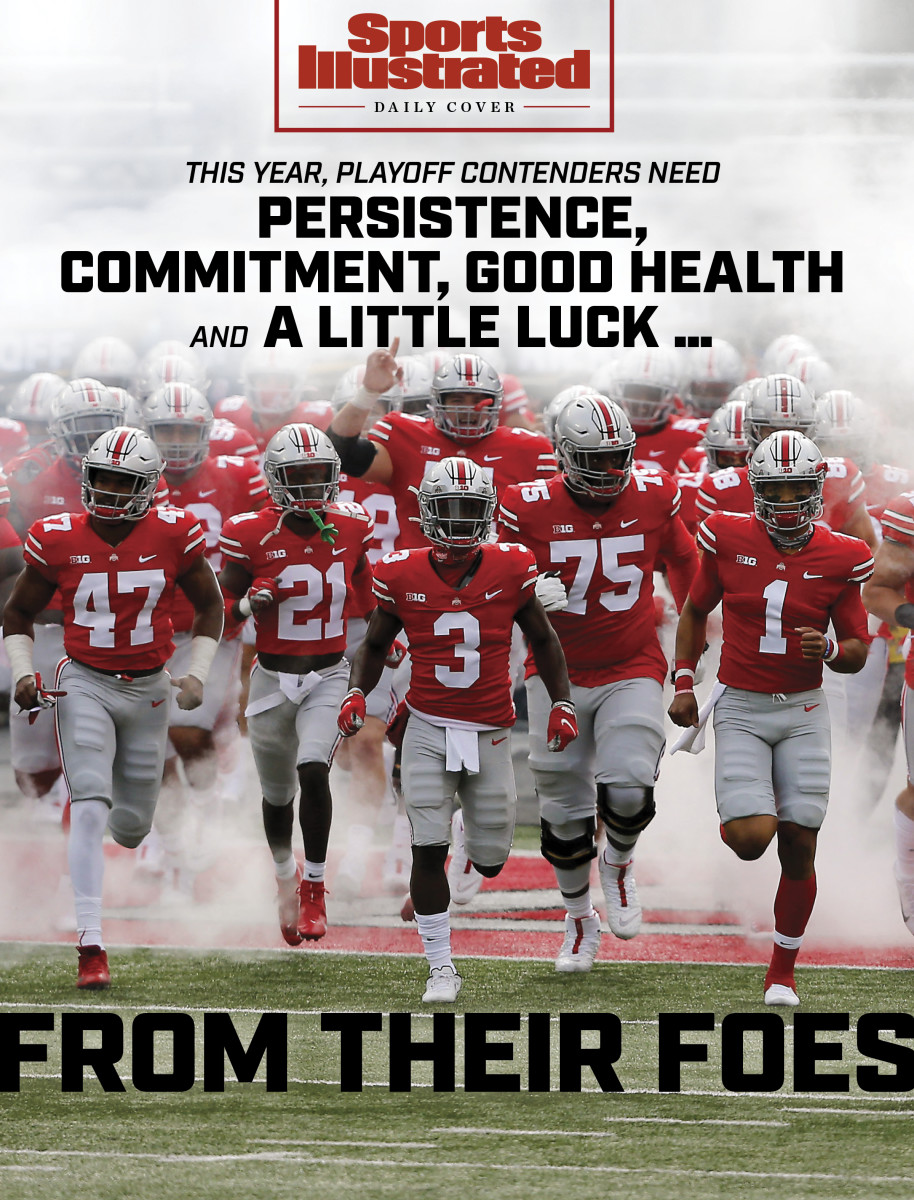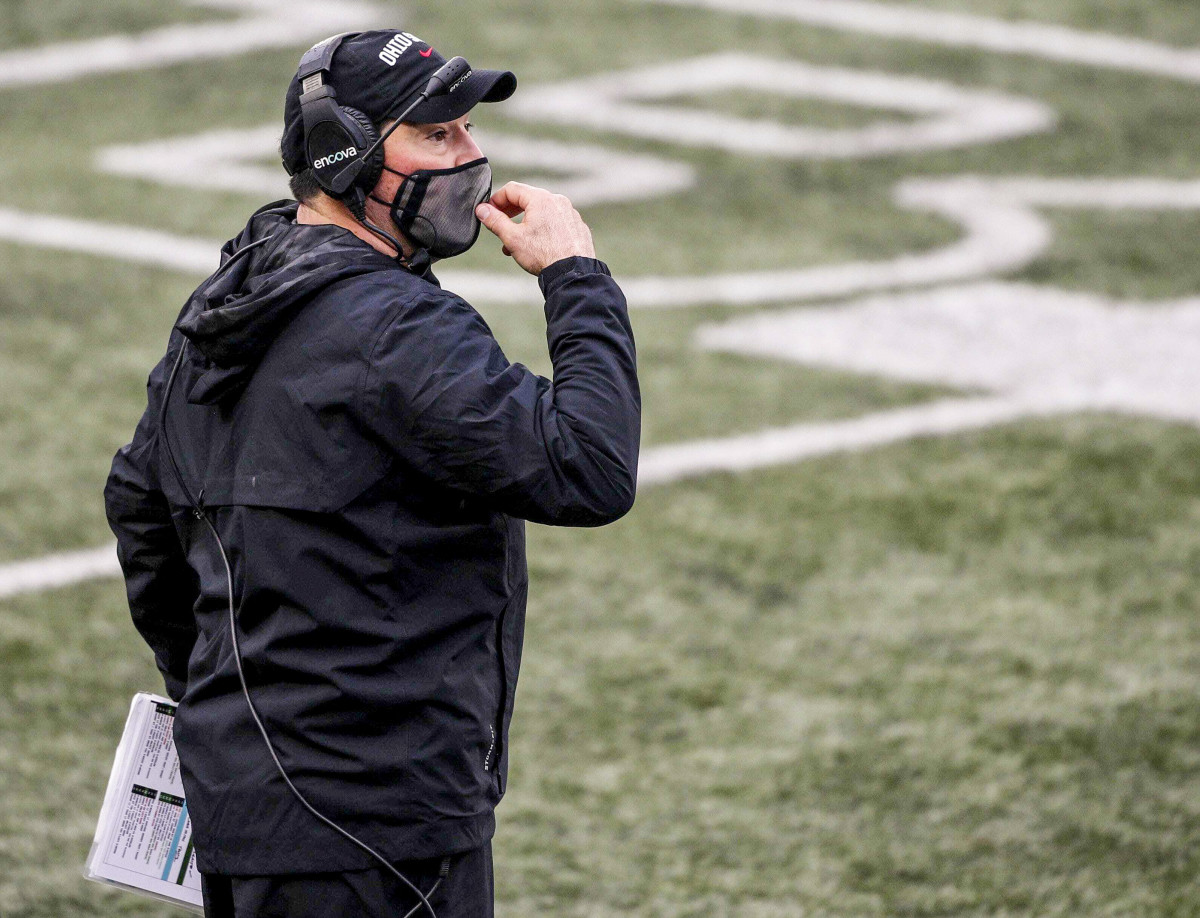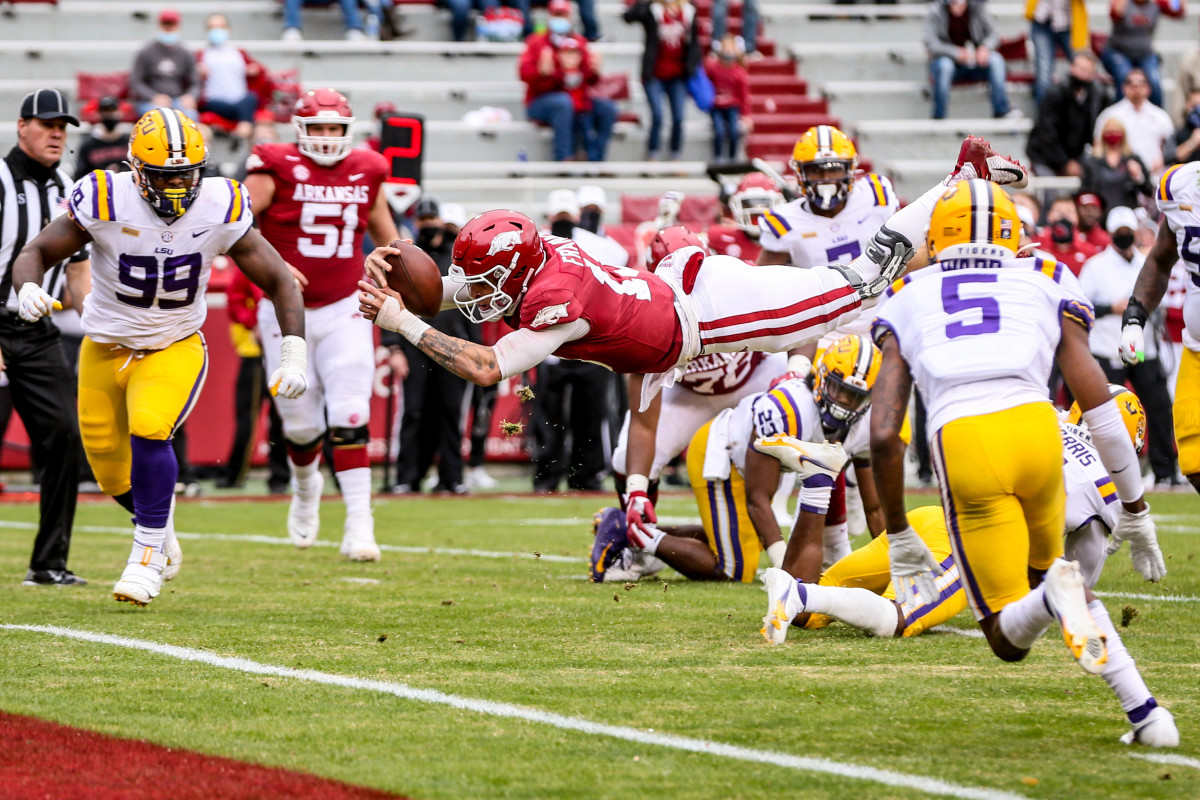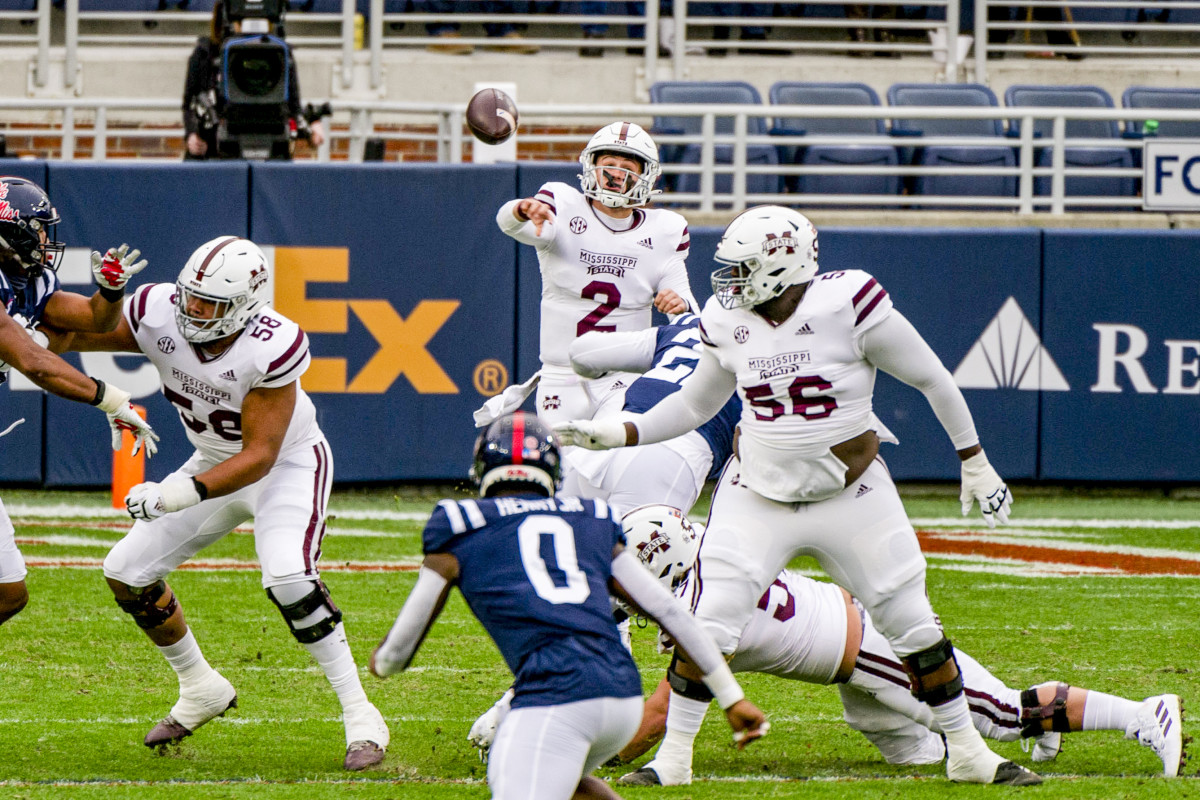Lend a Hand? Ohio State (and Others) Need Help From an Unexpected Source
COLUMBUS, Ohio — From his perch in the athletic director’s suite at Ohio Stadium, Gene Smith can hear the sounds and see the sights of the 2020 college football season: the roar of artificial crowd noise booming through an empty venue.
Minutes before the Buckeyes kicked off against Indiana in a top-10, unbeaten Big Ten showdown on Nov. 21, Smith was settling into his seat with a healthy dose of anxiety. He had allowed himself, for a brief moment, to glance forward to Ohio State’s final three regular-season opponents: Illinois, Michigan State and Michigan.
While the Buckeyes have championship aspirations, their opponents’ seasons were somewhat already lost. Concern over completing those games had already started to creep in. Opt-outs were on the rise. Injuries were mounting. And COVID-19 cases were spiking.

“That’s what we’ve got to watch,” Smith said. “Once we get past this one, it’s going to be interesting.”
He probably had no idea just how interesting.
Days later, his head coach tested positive and the Buckeyes canceled their game against Illinois because of a team-wide COVID outbreak, putting this week’s game with Michigan State in jeopardy, too (Ohio State resumed organized team activities Tuesday). Meanwhile, their final opponent, Michigan, has held no in-person activities the last two days because of potential COVID issues.
Interesting, indeed.
As the calendar turns to December, the handful of College Football Playoff contenders aren’t focused on only winning games. They’re just as worried about actually playing them. They’re at the mercy of something they cannot control: their opponents.
“Every year, you have teams in contention playing teams not in contention,” Florida athletic director Scott Stricklin says. “There’s never a question that those games will be played. This year, there is.”
The six legitimate playoff-contending Power 5 programs—Alabama, Notre Dame, Clemson, Ohio State, Texas A&M and Florida—are bracing as college football’s home stretch arrives about three weeks later than normal. The six teams have a combined 12 regular-season games remaining on their schedules. Four teams have two games left. Clemson has one, and the Aggies have three.

While COVID-19 issues on their own teams is always a concern, the viral health of their opponents is just as important. In a normal year the health of your opponent is something you might root against, but in this wacky season of 2020, the opposite exists: You need them healthy, at least healthy enough to field a team for a game. In an odd way, the opponents of playoff contenders hold the cards.
Alabama, for instance, needs SEC West rivals LSU this weekend and Arkansas next weekend to stay COVID-19 clean. Notre Dame will ask the same of Syracuse. For Clemson, it’s Virginia Tech. For Florida, it’s LSU and Tennessee.
But among the six teams, Ohio State and Texas A&M are in the most precarious position. The Buckeyes have the Michigan teams, and the Aggies have Auburn, Ole Miss and Tennessee.
With each lost game is a lost data point for two teams that need them. Ohio State, at best, will play seven games. Texas A&M is already saddled with a loss and will not have a conference title on its résumé.
For the Buckeyes, there is another wrinkle. With one more missed game, they wouldn’t qualify to play in the Big Ten championship game (Ohio State could, however, play that weekend regardless, as the conference plans to play a series of East-vs.-West games outside of the title matchup).
There is not a number of games that a team must play to be eligible for the playoff, but it is already a hot topic in the CFP selection committee meeting room. On Tuesday night, after the committee’s latest rankings were released, CFP committee chairman Gary Barta, the Iowa athletic director, says committee members spent significant time discussing the gap in games between a team like Texas A&M (seven games) and Ohio State (four games). He called it a “problem” and he noted that committee members debated on flipping the two. Ohio State is No. 4 and Texas A&M is No. 5.
“The more games a team brings to the committee, the more we have to evaluate,” he said.
With two weekends left before championship weekend, there is no more wiggle room. Protecting your team from a COVID-19 outbreak is more important than ever. And that goes for your opponent, too.
“Everybody has to be committed to finish the season. We’ve had long AD meetings talking about this,” says Texas A&M athletic director Ross Bjork, one of three SEC ADs with teams in contention. “We are committed to finishing the season. But if you don’t have the numbers, you don’t have the numbers.”
As the season grows, it’s becoming more difficult for teams to reach recommended or mandatory thresholds to field a competitive team (universally the number is 53). In the last four weeks, there has been a gradual uptick in impacted games each week—from 10 to 15 to 18 to 19. A combined 62 games have been postponed or canceled, or 25.4% of the 244 scheduled over that stretch. Those numbers exclude this weekend’s games, five of which have already been postponed or canceled.
COVID-19 numbers nationally aren’t helping. According to The New York Times, at least 17 states reported single-day records for new cases last week. And four states reported record deaths.
While it is concerning, it was predictable. Though few college football players and coaches have fallen seriously ill, the rise in community case numbers is leading to spikes on campuses and within athletic teams.

“We thought late fall and early winter there would be issues,” says West Virginia athletic director Shane Lyons, a member of the NCAA Division I Council. “The predictions are coming right.”
But COVID-19 is not the only reason behind these late-season game interruptions. As the season grows older, injuries increase and more players are choosing to opt out.
It’s a three-prong attack on a roster: COVID-19 + injuries + opt-outs.
“The sands are constantly shifting from under our feet from an availability standpoint,” Stricklin says. “The dynamics are a lot more fluid because there’s these additional areas of attrition that don’t normally exist.”
Because of opt-outs and injuries, some playoff contenders are entering games at least 10 to 15 players below the 85-player scholarship maximum. That’s the case for both Florida and Texas A&M, according to their ADs. During an average season, a team might be down six to 10 players at this point in a season because of injuries and normal offseason attrition, Bjork says.
“You take this year with opt-outs and add that to the injury list, you could be in the upper 50s before there’s a COVID impact,” he says.
Some of their opponents are much thinner. LSU, which plays both Florida and Alabama, is well below 85.
Because so many underclassmen left last year for the NFL, coupled with other roster attrition, LSU entered this season at least 10 under the NCAA maximum. Combine those numbers with eight opt-outs and at least a half-dozen injured players, and coach Ed Orgeron’s team is a small COVID-19 problem away from not meeting the SEC’s 53-man threshold. The Tigers postponed their scheduled game three weeks ago with Alabama after some positives led to the quarantining of more than 10 players.
Arkansas, Alabama’s opponent next weekend, is thin as well. The Razorbacks, in fact, had to postpone a game last week against Missouri and were close to postponing the game two weeks ago against LSU, says AD Hunter Yurachek.

They played the Tigers at such low numbers that they were forced to move defensive ends to defensive tackle. Yurachek suggested that Arkansas could have postponed the game against LSU if it wanted. The school received positive test results a day before the game.
“Coach [Sam] Pittman and I felt that was too late. We felt like it was tough to cancel that game on Friday,” he says. “The reason we even had a season is because we had 100-plus young men that love the game of football. The kids we had available this past week, they wanted to play Missouri. They want the challenge of playing a top-ranked Alabama team.”
Several SEC teams have played this season under the 53-man threshold. Teams are required to play if they have at least 53 available scholarship players (and meet minimum requirements at positions), but they are given a choice if they fall under that threshold.
Mississippi State has at least twice chosen to play despite being under the threshold. Excluding kickers and punter, the Bulldogs played with 45 scholarship players against Ole Miss last week, says Mississippi State athletic director John Cohen.
Cohen described the decision to play as a “group thing” in conjunction with SEC headquarters. Leagues are approaching this issue differently. While the ACC allows its own teams to make such decisions, the SEC is more involved in game postponements. For instance, if a similar Clemson–Florida State gameday debacle would have unfolded in the SEC, the conference headquarters would have likely determined the course of the game.
Above all, the top priority for both school and conference is protecting the players and assuring that they are not placed in harm’s way, Cohen says.
“We played Georgia, and our defensive coordinator was teaching a defensive player how to play a position he’s never practiced before. That’s not normal,” Cohen says. “But I do believe the kids want to compete.”
Both Mississippi State and Arkansas’s numbers are impacted by an abnormal number of player dismissals and departures, both Yurachek and Cohen say. They attribute the attrition to having first-year head coaches. Even in a normal year, a new coach can often lead to roster turnover. New schemes and different approaches don’t necessarily jell with players who the previous staff have recruited.
In a COVID-19 year, that is exacerbated. Coaches had no or little spring practice and interrupted summer workouts and preseason camp. With injuries, departures and opt-outs, the Bulldogs are below the 60-player mark, and that’s excluding any COVID-19 issues.
“The coaches are trying to create a discipline environment,” Cohen says, “but let’s be real: The [opt-out] rules that have come out, rightfully so, are for the individual. You have the team vs. the individual going on.”

The increasing number of opt-outs are making matters more difficult. Over the last several days, college football has seen a spike in players calling it quits on the season to prepare for the NFL draft. LSU lost its top receiver. Florida State lost its second-leading rusher and a cornerback. Texas lost a defensive back and offensive tackle.
This isn’t necessarily coincidental. In a normal year, the regular season would have ended this past weekend. Players who had already planned to skip their team’s bowl game are pulling the plug even before the COVID-19-delayed regular season ends.
For those in contention for a championship or even a significant bowl berth, the motivation to play is clear and obvious. But what about those teams playing a lost season in a year in which COVID-19 brings so much uncertainty around the postseason?
“I’ve been at places that had teams with losing records and the coach had been fired and players weren’t real motivated other than they like to play,” Stricklin says. “Even in those situations, you don’t normally have a situation where kids are questioning whether they’re going to finish the year. This is such a unique situation.”
In no real surprise, the recent opt-outs have not come from teams contending for a championship. Instead, their opponents are experiencing the attrition.
“You control what you can control,” Alabama athletic director Greg Byrne says. “So much of this year is out of your hands. All you need is a small number of positives that with contact tracing can lead to a lot of people not being available. That’s why it’s so important that your student-athletes and staff understand to wear a mask, social distance and wash your hands. It’s important to educate and do the right things. Respect the virus and respect other people.”
And so, down the stretch the playoff contenders go—hoping not only that they field healthy enough teams but also that their opponents do.
“The uncertainty is unreal,” said Smith, speaking at Ohio Stadium before the Buckeyes’ game against Indiana. “Just yesterday, I talked to our women’s ice hockey team—they were going to Minnesota—and told them to enjoy these two games and enjoy the moments. You don’t know if next week is going to happen.”
Four hours later, the Buckeyes’ football team finished off a win over Indiana. And then, well, things got interesting.
